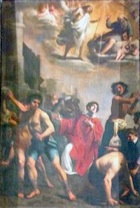

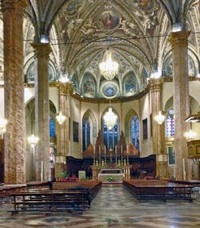
The Duomo is in the form of a “Hallenkirche” (hall church), so-called because the nave and flanking aisles are of equal height. The nave culminates in a polygonal apse while each of the aisles culminates in a small rectangular chapel.
Bishop Jacopo Vannucci pierced the side walls of the church in 1481 to build transepts. The larger chapel in the right transept (the original Cappella di Sant' Onofrio) served as the bishop's burial chapel and later as the winter choir for the canons. In 1608, a dividing wall was built across it so that the transept chapels achieved their current symmetry.
The interior owes its current appearance to Bishop Alessandro Maria Odoardi, who commissioned the stucco decoration in the nave, the false marble painting over the originally brick octagonal columns and the frescoes on the vaults in the late 18th century. Bishop Gioacchino Pecci commissioned the frescoes that cover the walls and the new marble paving of the floor some fifty years later.
Counter-facade
Monument to Giovanni Andrea Baglioni (1451)
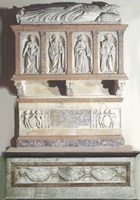
In the current arrangement, the effigy lies above a series of reliefs of the four Cardinal Virtues above the sarcophagus. A drawing made just before the monument was moved to its current location shows that, at that point, the effigy lay directly on the sarcophagus, with the reliefs below.
The inscription on the sarcophagus records the role of Giovanni Andrea Baglioni in the reconstruction of the Duomo and is dated 1451, two years after his death.
Madonna and Child with saints (1610-7)
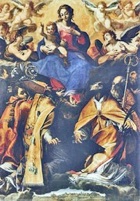
The panel depicts the Madonna and Child in Glory, above a cityscape of Perugia, with:
-
✴SS Herculanus, Constantius and Laurence, the patron saints of Perugia; and
-
✴SS Dominic, Augustine and Francis, the patrons of the Perugian confraternities that commissioned the panel.
Monument to Marcantonio degli Oddi (1658)
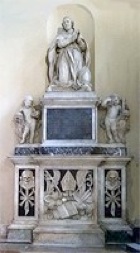
Martyrdom of St. Laurence (1919)
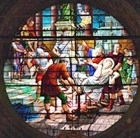
Left Wall
The Cappella del Santo Anello is the first chapel on the left, in the corner with the counter-facade.
God the Father Blesses Perugia (1602)
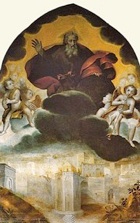
Virgin in Glory with Saints (1740)
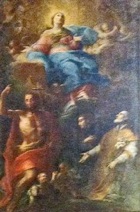
Cappella del Gonfalone
This chapel on the left wall is named for the processional banner that now serves as its altarpiece (see below).
Risen Christ with SS Lawrence and Herculanus (1513)

Three other panels from the screen (a tondo of the martyrdom of St Lawrence and panels of SS Peter and Paul) are now in the Museo Capitolare - see also Art from the Duomo, below.
Processional banner (1526)
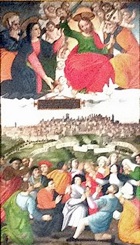
Presbytery
The presbytery took on its present form when the canons’ choir was moved from the nave to its current location in 1524, to comply with the requirements of the Council of Trent. Following the installation of a monumental tabernacle (below), Cardinal Bishop Antonio Maria Gallo reconsecrated the high altar in 1587.
Bishop Francesco Riccardo Ferniani consecrated the new high altar (1761-2), which was designed by Carlo Murena and built by Francesco Caselli. He was roundly criticised for destroying the tabernacle so that its gold leaf could be recovered and sold for “a few scudi”.
Pope John Paul II visited the Duomo in 1986, and the subsidiary altar that conforms to the recommendations of the Second Vatican Council was erected at the time of this visit.
Choir stalls (1489-91)
Bishop Dionisio Vannucci commissioned the choir stalls, which carry the inscription:
Opus luliani Maiani et Dominici Taxi Florentini MCCCCLXXXXI
Scholars believe that they were designed by Giuliano da Maiano and completed by Domenico del Tasso after Giuliano’s death in 1490. As noted above, they were moved from the nave to their present location in 1524. The right hand stalls were destroyed in a fire in 1985, and have been replaced by copies.
Pulpits (1519)
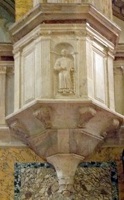
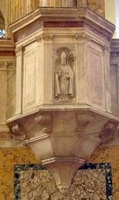
Rocco di Tommaso da Vicenza designed these pulpits on the pillars framing the tribune as part of the redesign of the apse mentioned above. They incorporated statues of SS Lawrence (on the left) and Herculanus [that possibly came from the monument (13th century) to Pope Martin IV that was originally in the old Duomo, in which case they could be by Giovanni Pisano].
Bishop’s throne (1520-4)
Ciancio di Pierfrancesco da Perugia built this throne to Rocco di Tommaso’s design.
Tabernacle (1579)
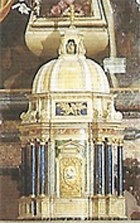
The tabernacle was largely destroyed in 1762, as mentioned above: only the upper part survives, on the altar of the Cappella di San Francesco, to the left of the presbytery - see below. [It was not there at the time of my visit of 2013] A drawing (18th century) by Baldassarre Orsini of the complete tabernacle survives in the Accademia di Belle Arti.
Scenes from the Life of St Laurence (1767-8)
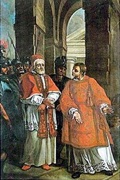
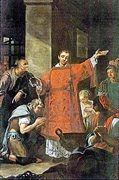
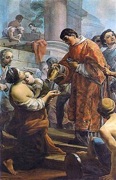
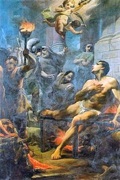
The panels in the apse are by two different artists:
-
✴two are by Carlo Spiridione Mariotti:
-
•St Laurence accompanying Pope Sixtus to his execution; and
-
•St Laurence baptises his fellow-prisoners;
-
✴two are by Baldassarre Orsini, as described in his “Guida di Perugia”:
-
•St Laurence distributing arms, which includes his self-portrait (at the extreme right); and
-
•the martyrdom of St Laurence.
Apsidal Chapels
Cappella di San Francesco (1620)
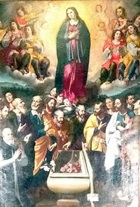
Pierantonio Ghiberti commissioned the altarpiece (1620) of the Assumption of the Virgin from Ippolito Borghesi.
Cappella di Sant’ Emidio (1784)
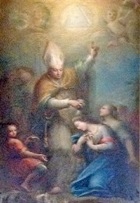
The altarpiece by Francesco Appiani shows St Emidius baptising Polisia, the daughter of the Roman prefect.
Sacristy
The portal (15th century) on the right wall of the Cappella di Sant’ Emidio leads to the sacristy, which Bishop Giovanni Andrea Baglioni commissioned in 1438. Cardinal Fulvio della Corgna, Bishop of Perugia commissioned its vaulting (1572). He also commissioned the Sacrestia dell’ Arciprete behind the back wall of the sacristy as his burial chapel.
Wooden Furniture (1494-7)
The furniture on the right wall was commissioned from Mariotto di Paolo Sensi, il Terzuolo in 1494 and he was paid for the work in 1497. The cartoons for the carvings of SS Herculanus, Peter, Paul and Constantius are attributed to Giannicola di Paolo.
Frescoes (1573-6)
Cardinal della Corgna commissioned these frescoes from Giovanni Antonio Pandolfi of Pesaro. They include large figures of SS Herculanus, Constantius, Gregory, Ambrose, Augustine and Jerome (the last four being the Doctors of the Church) and scenes from the life of St Lawrence.
Martyrdom of St Lawrence (late 16th century)
The altarpiece of the the Sacrestia dell’ Arciprete is by Ferraù Fenzoni da Faenza (il Faenzone).
Right Transept
Bishop Jacopo Vannucci established the Cappella di Sant' Onofrio in the right transept in 1481. The chapel subsequently passed into disrepair, and its altar was demolished in ca. 1608.
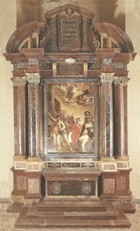
The doors to the sides of the altar lead to the Oratorio di Sant' Onofrio (17th century), which the canons used as a winter choir. It is usually closed.
Martyrdom of St Stephen (ca. 1608)
Pope Leo XIII (1892)
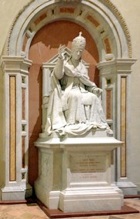
Papal Mausoleum (1615)
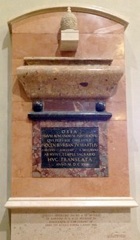
-
✴Pope Innocent III (in 1216);
-
✴Pope Urban IV (in 1264); and
-
✴Pope Martin IV (in 1285).
Their original monuments in the old Duomo had probably been destroyed in 1373, during the depredations of the papal legate Gérard du Puy, Abbot of Marmoutier, (known to the Italians as “Monmaggiore”). Thereafter, the papal remains had been placed in an iron casket in the sacristy until Bishop Comitoli re-interred them.
The present monument, which was rebuilt in 1960, contains the remains of Martin IV and reliquaries of Innocent III and Urban IV (as recorded in the inscription at the bottom):
-
✴Leo XIII moved the remains of Innocent III to a new mausoleum that he erected in the right transept of San Giovanni Laterano, Rome in 1891.
-
✴The remains of Urban IV were transferred to the cathedral of Troyes (the city of his birth) in 1901.
Right Wall
The entrances in the right wall opens into:
-
✴the Cappella dello Spirito Santo; and
-
✴the Baptistery.
The Cappella di San Bernardino is in the corner, near the counter-facade.
Martyrdom of St Sebastian (1576)
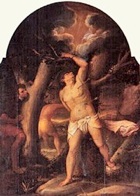
Birth of the Virgin (ca. 1610)
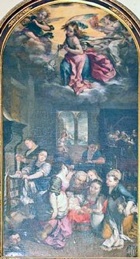
Madonna delle Grazie (ca. 1515)
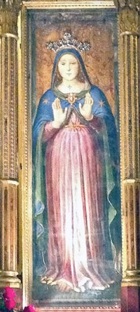
This panel has traditionally been attributed to Giannicola di Paolo, [but it has been more recently attributed to Perugino??].
Art from the Duomo
Death of the Virgin (1432)
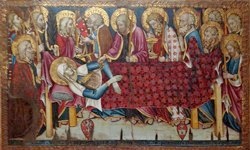
The inscription on this panel records that Pietro di Giovanni and his parishioners commissioned it in 1432 in honour of God and the Virgin. Two coats of arms flank the inscription: one is the griffin of Perugia and the other probably belonged to the commissioner. The altarpiece, which is in an anachronistic style, depicts the Virgin on her death bed, surrounded by the Apostles. It is now in the Museo Capitolare.
Processional Icon (1453)
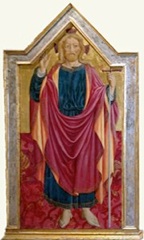
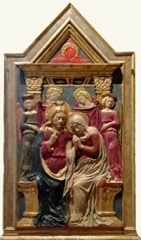
This wooden double-sided icon by Battista di Baldassare Mattioli was commissioned to replace an earlier one that was used in the annual procession from the Duomo to Santa Maria di Monteluce on the Feast of the Assumption of the Virgin. The procession was revived in 1999, using a reproduction of this original, which is now in the Museo Capitolare.
The icon depicts:
-
✴Christ the Redeemer on one side; and
-
✴the Coronation of the Virgin on the other.
Altars by Agostino di Duccio
Much of the original decoration of the Duomo was done under Bishop Jacopo Vannucci, and since he had previously been Bishop of Rimini, he drew on the example of the Malatesta Temple, which explains the stress on sculpted rather than painted altarpieces at this time. It was probably Bishop Vannucci who invited Agostino di Duccio to Perugia from Rimini.
Altare di San Bernardino (1473)
This altar is described in the page on the Chapels of the Duomo.
Altare della Pietà (1473-4)
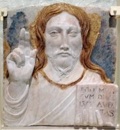
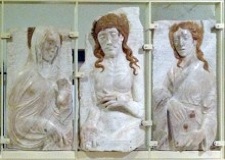
This altar, which was on the left wall (between the entrance to the external pulpit and the side door), was built according to the provisions of the will of Nicolò Ranieri. He named the Ospedale di Santa Maria della Misercordia as his heir on the condition that they would erect a chapel in the Duomo. The Cathedral Chapter conceded the necessary space and the Prior of the hospice duly commissioned the work from Agostino di Duccio in 1473. The documentation specified reliefs of Christ “in pietà”, between the Virgin and St John the Baptist, with God the Father above. The altar was complete by 1474, when two local sculptors pronounced it to be well-executed and worthy of its cost.
In 1625, by which time the funds to maintain the use of the altar had been exhausted, Bishop Cosimo de Torres ordered its demolition. Some fragments were recorded at the time of the apostolic visit of 1660: they were still embedded in the wall, although the surrounding structure had been demolished. Costantino Ranieri undertook their restoration in 1703, so that the altar could once more be used for services. However, it had fallen into disuse again by 1792, when it was definitively demolished.
A number of surviving fragments (including those illustrated above) were returned to the left wall of the Duomo in 1832. They were removed for restoration i [the 1990s?] The surviving fragments, which include some that were discovered only recently, were restored and placed on display in the Museo Capitolare in 2013.
Panels from the Organ Screen (1514)
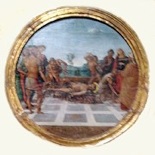
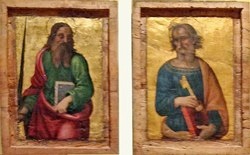
Four [documented?] panels by Giannicola di Paolo survived when the organ screen of the Duomo was demolished in 1784. They comprise:
-
✴a lunette depicting the Risen Christ with SS Laurence and Herculanus, which is now above the altarpiece of the Cappella del Gonfalone(above); and
-
✴three panels that are now in the Museo Capitolare:
-
•a tondo of the martyrdom of St Lawrence, dated by inscription; and
-
•panels of SS Peter and Paul.
St Nicholas Altarpiece (1529)
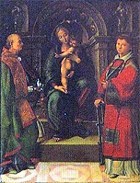
The altarpiece depicts the Madonna and Child enthroned with:
-
✴St Nicholas of Bari, who carries the three bags of gold which he used to save the daughters of a poor man from prostitution; and
-
✴St Laurence, who holds the grill on which he was martyred.
Altare di San Sebastiano (1576)

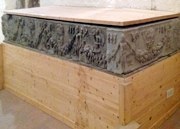
The Cantagallina family commissioned this marble altar for the counter façadein the Museo Capitolare (Room 11). They include:
-
✴elements of a long inscription that includes the family name; and
-
✴a marble frieze.
(The original altarpiece (1576) of the Martyrdom of St Sebastian by Orazio Alfani is now on the right wall - see above).
St Laurence (1562)
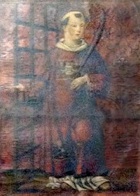
Deposition (1729)
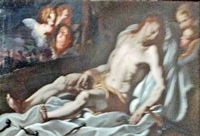
This altarpiece in the Museo Capitolare, which presumably came from the Duomo, is signed by Giacinto Boccanera and dated by inscription.
Scenes from the Life of St Laurence (18th century)
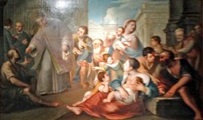
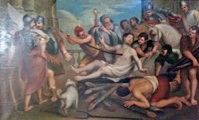
These two panels in the Museo Capitolare, which presumably came from the Duomo and are attributed to Baldassarre Orsini, depict:
-
✴St Laurence distributing arms; and
-
✴the martyrdom of St Laurence.
See also the section “Art from the Chapels” in the page on the chapels of the Duomo, using the link below.
